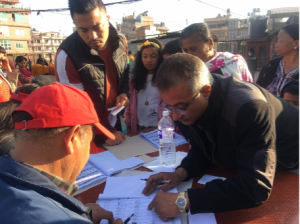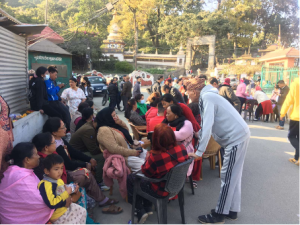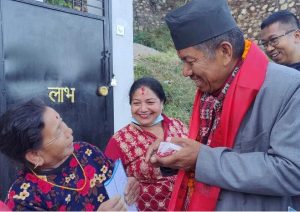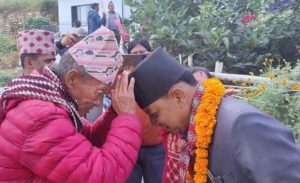
Sagar Manandhar manages the Forum’s Nepal’s country office. He holds a Masters Degree in Business Administration and is currently completing a Masters in Economics and a Bachelor in Law from the Tribhuvan University in Nepal. Before coming to the Forum, Sagar was in investment banking and credit administration in Nepal
The recent federal and provincial elections in Nepal demonstrate the country’s continued progress toward federalism and the emergence of new political actors challenging the traditional parties. Voters across the country elected 825 legislators to serve a second term in provincial and federal legislatures. The success of Nepal’s second periodic election and the formation of government at the federal and provincial levels by the constitution, has given the federal system new legitimacy. Voters have already vested responsibility for decision making in legislators. Political parties and elected lawmakers are now responsible for carrying out the spirit of the constitution and the agenda of the federal model of national development.
Electoral System in Nepal
The Nepal Constitution calls for periodic elections to ensure the proper functioning of the President, Vice-President, Federal Parliament, Provincial assemblies, and local bodies. Nepal held its local election on May 13, 2022, followed by the election for the federal parliament and provincial assemblies on November 20, 2022. Periodic elections have been viewed as a means to institutionalize the federal system of governance, which includes three levels of government: federal, provincial, and local.
The bicameral federal parliament is divided into two houses: The National Assembly (upper house), which has 56 members elected by an electoral college and three appointed by the President; and the House of Representatives (HoR), which has 275 members directly elected by voters through a mixed parallel electoral system for five-year terms.
The country is divided into 165 electoral constituencies for lower house elections. Members are elected using the first-past-the-post (FPTP) electoral system, with one representative elected from each of the 165 electoral constituencies, defined by geography and population. The remaining 110 members are selected through a proportional representation (PR) electoral system that treats the entire country as a single electoral constituency.
Provinces in Nepal have a unicameral legislature known as the Provincial Assembly (PA). A mixed parallel election system has been used to elect the provincial assembly members. Nepal has 550 provincial seats spread across its seven provinces, in which FPTP is used to elect 330 (60%) seats and PR is used to elect 220 (40%) of seats.

Voters searching for their names on voter lists.
The Electoral System and Inclusion
The Nepalese constitution states unequivocally that the electoral system must be representative of the country’s population with regard to gender, ethnicity, religion and languages. According to Article 84(8), at least one-third of the total number of members elected to the HoR from each political party must be women. If the one-third requirement for women’s representation is not met through the results of the FPTP vote, the party must make up the difference through the PR list. The constitution also requires political parties to submit a closed list of candidates for the HoR election through the PR system, ensuring inclusive representation of women, Dalits, Adibasi-Janajatis (indigenous/ethnic communities), Khas Aryas (Chhetri, Brahmin, Thakuri, and Sannyasi/Dasnami communities), Madhesis, Tharus, Muslims, and geographically remote, underdeveloped (“backward”) regions. The provision also requires parties to balance candidates geographically and by province, as well as to consider the representation of people with disabilities. Similarly, Article 176 requires that at least one-third of the total number of members elected to the PA from each political party be women. The PR system further ensures Dalits, Adibasi-Janajatis, Khas Aryas, Madhesis, Tharus, Muslims, geographically remote (“backward”) regions, minority communities, and people with disabilities are represented at Provincial Assembly level.
The establishment of a PR electoral system in the constitution stems from Nepal’s long history of inequity based on regions, communities, genders, classes, etc. Implementing a PR electoral system aims to ensure the representation of people from marginalized and underrepresented communities in the state organs. According to the PR system, 40% of lawmakers in the House of Representatives and Provincial Assemblies are elected. However, when distributing candidacy tickets during this election, the major political parties were seen to disregard the constitutional provisions on representation. As a result, women made up only 10.25 % of the candidates nominated for the HoR and 8.54 % for the PA elections. The election commission claimed that it had repeatedly drawn the attention of political parties to women’s representation in elections. However, these efforts did not produce the desired results and number of women candidates put forward for election failed to meet the one-third threshold enshrined in the constitution.
Following the PR system, political parties contesting elections across the country submitted shortlists of candidates. Many of the names on the lists, however, show how Nepal’s political parties continue to abuse the PR electoral system excessively. Parties nominated wives and sisters of influential leaders, controversial figures, and businesspeople, reflecting a trend of favouritism and nepotism. This trend was particularly prominent in this election – in previous elections, parties repeatedly abused the PR system by hand-picking individuals from their lists to become members of the house and assemblies.

Electoral Alliance
Major political parties formed an electoral alliance in the federal and provincial elections to maximize their gains across the country. The parties viewed the alliance as a tool to ensure the most favourable outcome in terms of their electoral performance. However, allying caused conflict and dissatisfaction among party structures and members when it came to the distribution of candidacy tickets. These dynamics were also seen in the alliances formed during the local elections in May 2022.
The disarray in the alliance was particularly visible during the distribution of the tickets. Leaders and party cadres who have given their lives for the party were dropped from the list in favor of candidates with money and the support of the alliance’s other parties. This also led to a rise in the number of rebel candidates challenging alliance candidates. Even voters recognized that the coalition among the parties was motivated by a desperation to win more seats, rather than ideological similarity or convergence. The need and desire to win seats in any way resulted in candidates switching political allegiances in the final hours, depending on which alliance offered them a better deal.
In this election, both the incumbent and opposition parties formed electoral alliances. On one side, there was the ruling coalition, which included Nepali Congress (NC), Communist Party of Nepal-Maoist Center (CPN-MC), Communist Party of Nepal-United Socialist (CPN-US), the Terai-based Loktrantrik Samajwadi Party (LSP), and Rashtriya Janamorcha (RJ). On the other side, the opposing alliance included the Communist Party of Nepal Unified Marxist-Leninist (CPN-UML), Rashtriya Prajatrantra Party (RPP), and Janata Samajwadi Party (JSP). Alliance members agreed to propose and support common or joint candidates in both the incumbent and opposition groups. Nonetheless, parties in both alliances issued separate manifestos advocating for their independent existence in the party system.

Candidates meeting with voters during the election campaign.
Rise of the New Political Parties and Independent Candidates
Voters across the country expressed dissatisfaction with the old political parties and their candidates in the federal and provincial elections. New political parties and independent candidates took advantage of the voters’ dissatisfaction with the traditional parties. A number of social-political campaigns were launched by the new players to achieve this goal. For example, a social media campaign with the hashtag #NoNotAgain primarily promoted independent candidates while demanding that all major parties’ ‘old and corrupt’ leaders be replaced. Popular campaigns such as these have caused voters to question the credibility of current leaders and parties while also driving voter sentiment toward the hope of seeing fresh candidates from new parties or independents. Social media campaigns also circulated the message that a new generation of youth leaders was gaining influence in the election campaign and aiming to win seats in various constituencies. This has shaken up the old guard in all parties that have maintained political supremacy for so long.
This election was therefore a litmus test for new political parties and independent candidates. Many took advantage of the opportunity to connect with voters by embracing more progressive development agendas such as increased job creation, eliminating corruption, increased access to health and education, promoting women’s rights, tourism, and tackling climate change, among others. This pattern matches what was seen in the local polls in May 2022. The victories of independent candidates such as Kathmandu Mayor Balen Shah and Dharan Mayor Harka Sampang gave new parties and independent candidates hope. This election has revealed that a sizable proportion of the Nepal electorate is seeking alternative leaders, particularly those with a new face or party.
Election Result and Government in Coalition
The Election Commission of Nepal (ECN) announced the final results of the House of Representatives and Provincial Assembly elections on December 14. At the final count, 12 parties secured representatives in the House of Representatives. Seven of these parties have evolved into national political parties: Nepali Congress (NC), Communist Party of Nepal-UML (CPN-UML), Communist Party of Nepal-Maoist Center (CPN-MC), Rastriya Swatantra Party (RSP), Rastriya Prajatantra Party (RPP), Janata Samajbadi Party (JSP), and Janamat Party (JP).
NC became the largest party, winning 79 seats. CPN-UML gained the position as the second-largest party with 78 seats, while CPN-MC came in third place with 32 seats. RSP and RPP won 20 and 14 seats respectively. Similarly, JSP and JP secured 12 and 6 seats in the House of Representatives, respectively.
In addition to these seven national parties, Nagarki Unmukti Party (NUP), Nepal Workers and Peasants Party, Rastriya Janamorcha, and five independents will also be represented in parliament.
The election results from across the country revealed different faces and facets of Nepal’s representative democracy. New political parties have emerged in areas where mainstream parties are lacking popular support. The best examples of this include the rise of RSP as a counter-product to traditional politics, and Janamat Party as an avenue for new Madhesh politics. Many senior political leaders were perplexed by the election results, as they lost their seats to new and young leaders from diverse professional backgrounds.
With no one party having a majority, voters were eager to see who would lead the country as Prime Minister and how the new government would take shape. The President’s deadline for parties to put forward a Prime Minister as the head of a government with majority support changed the whole game of the power-sharing agreement as established in the electoral alliances. Because no one party secured a majority, the President asked any member of the HoR to demonstrate a majority with the support of other parties, as required by the constitution. Pushpa Kamal Dahal (Prachanda), the Chairman of the CPN-MC, was appointed as the new Prime Minister of Nepal on December 25. The President appointed Prachanda as the new Prime Minister of Nepal after Nepali Congress, the largest party in the federal parliament, failed to stake a claim to form a new government by obtaining a clear majority in the House of Representatives within the time limit as required by Article 76 (2) of the Nepali Constitution.
Prachanda switched sides with Nepali Congress and sought CPN-UML support to meet the constitutional requirement for forming a government. CPN-UML and CPN-MC agreed to share power for the next five years, so Prachanda will be Prime Minister for the first two and a half years of the term, followed by KP Sharma Oli, Former Prime Minister and President of CPN-UML for the final two and a half years. Prachanda was backed by 78 CPN-UML MPs, 32 CPN (MC) MPs, 20 RSP MPs, 14 RPP MPs, 6 JP MPs, 4 NUP MPs, and 12 JSP MPs. Meanwhile, Nepali Congress also showed its confidence in the new PM. The picturesque of the house is now unclear as to which parties are in the government and which parties are in the opposition.
New Phase of Federal Implementation Begins
The constitution has now been in effect for more than seven years, two periodic elections have been held, and federalism has progressed to the subsequent implementation stage. It is worth noting that the implementation of federalism in Nepal has been contentious, with some claiming that it has increased polarization and political instability. There have also been disagreements about resource allocation and power distribution among the central government, provinces, and local governments. Despite these challenges, federalism has the potential to address Nepal’s long-standing issues of inequality and underdevelopment by enabling more decentralized decision-making and greater local control. It will be interesting to see how federalism evolves in Nepal and how it affects the country’s political landscape in the coming years. However, seven years after the promulgation of a federal constitution, the progress of federalism provides hope for developing an effective, representative governance system capable of addressing Nepal’s challenges and meeting the needs and interests of its diverse population.
The new federal parliament and provincial assemblies will govern the country and deal with economic development and poverty reduction issues. Overall, the federal and provincial elections in Nepal were a watershed moment in the country’s democratic development, leading to significant changes to the political landscape. It is now up to the new governments and elected representatives to work together to address the nation’s challenges and promote the welfare of the Nepalese people.

Renewed Challenges for the Newly In-Charge
It is high time for the new governments at all three levels to reevaluate the performance of the federal and subnational government units on the benchmark of constitutionally devolved powers. A clear roadmap on the ability of each government to exercise power as per the provisions of the Constitution is necessary and meaningful for improved inter-governmental relationships. The Constitution has envisioned coordination, cooperation, and coexistence among all three levels of government, which is vital to the success or failure of federal politics. Recognizing Nepal’s three levels of government’s the complex array of sharing arrangements between the three levels of government (as outlined in the Constitution), Nepal’s newly elected decision makers should embrace and pursue the principles of cooperation, coexistence, and coordination across all spheres of power. Because constitutional provisions alone cannot guarantee these principles, practices, or outcomes, all three levels of government and elected leaders must work together to implement federal governance in Nepal.
The Preamble of the Nepal constitution explicitly defines the country as an egalitarian society based on proportional inclusion and representation principles to ensure economic equality, prosperity, and social justice by assimilating and recognizing the multi-ethnic, multi-lingual, multi-religious, multi-cultural, and geographically diverse characteristics of the nation. Efforts will be made to establish this egalitarian society in Nepal with each election and formation of a new government with a new mandate. Federalism will be the driving force of Nepali society and the country’s governance tool as it works towards a brighter future.







